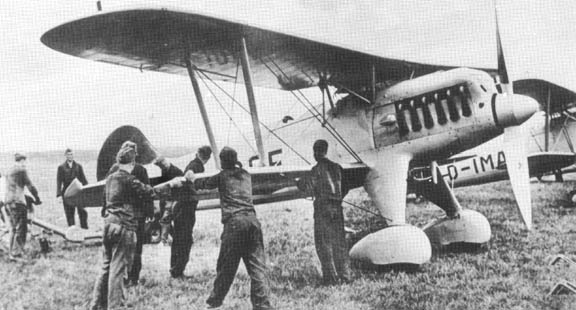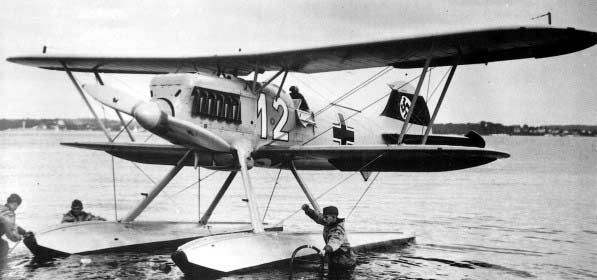LUFTWAFFE RESOURCE CENTER > FIGHTERS/DESTROYERS > PREVIOUS PAGE
Heinkel He 51

Type:
He 51A-1 Single Seat Fighter
He 51B-2 Reconnaissance seaplane
He 51C-1 Land ground attack
Origin: Ernest Heinkel AG
Models: He 51A-1, B-2, and C-1
First Flight: May 1933
Service Delivery: July 1934
Final Delivery: N/A
Production:
He 51A-1: 75
He 51B-2: 80
He 51C-1: 79
Engine:
Model: BMW VI 7.3Z
Type: V12 water-cooled
Number: One Horsepower: 750hp
Dimensions:
Wing span: 11m (36 ft. 1 in.)
Length: 8.4m (27 ft. 6¾ in.)
Height:
Typical: 3.2m (10 ft. 6 in.)
He 46B-2: 3.35m (11 ft.)
Wing Surface Area: N/A
|
|
Weights:
Empty: 10,734 lb. (4870 kg)
Maximum: 13,262 lb. (6016 kg)
Performance:
Maximum Speed (A-1): 205 mph (330kph)
Initial climb: 1,969ft/min (600m/min)
Range: 242 miles (390km)
Service Ceiling: 24,610 ft. (7500m)
Armament:
Typical:
Two 7.92mm Rheinmetall MG 17 synchronized above fuselage
He 51B-2:
Same plus underwing racks for up to six
22 lb. (10kg) bombs
He 51C-1:
Same plus underwing racks for up to four 110 lb. (50kg) bombs
|
The Heinkel He 51 was a German single-seat biplane which was produced in a number of different versions. Initially developed as a fighter, a seaplane variant and a ground-attack version were also developed. It was a development of the earlier Heinkel He 49.

He 51.
In 1931, Heinkel recruited the talented aircraft designers, Walter and Siegfried Günter, and their first major design for Heinkel was the Heinkel He 49. While this was officially an advanced trainer, in fact it was a fighter. The first prototype, the He 49a, flew in November 1932, and was followed by two further prototypes, the He 49b, with a longer fuselage, and the He 49c, with a revised engine.
The type was ordered into production for the still secret Luftwaffe as the Heinkel He 51, the first pre-production aircraft flying in May 1933. Deliveries started in July of the next year.
The He 51 was a conventional single bay biplane fighter, with all-metal construction and fabric covering. It was powered by a glycol-cooled BMW VI engine, with an armament of two 7.92 mm machine guns mounted above the engine.

He 51B-2 Float plane, 1936.
The He 51 was intended to replace the earlier Arado Ar 65, but served side-by-side with the slightly later Arado Ar 68. The He 51 was outdated the day it entered service, and after an initial run of 150 production fighters, the design was switched into the modified He 51B, with approximately 450 built, including about 46 He 51B-2 floatplanes, and then finally a further 100 He 51C light ground attack plane.
Operational History:
On 6 August 1936, six of the He 51s were delivered to Spain to fight in the Spanish Civil War. Initial operations were successful, the Heinkels meeting and defeating a number of older biplane designs, with two Nieuport Ni-52 fighters, a Breguet 19 and a Potez 54 destroyed on 18 August 1936, the first day of operations by Spanish flown He 51s. Deliveries continued as the hostilities increased, with two Nationalist squadrons equipped by November, and the Legion Condor (Condor Legion) forming three squadrons of 12 aircraft each manned by German "Volunteers".

He 51 of the Kondor Legion.
This time of superiority was short lived, with the arrival of large numbers of modern aircraft from the Soviet Union, including the Polikarpov I-15 biplane and new Polikarpov I-16 monoplane, together with the Tupolev SB bomber, which was 110 kph (70 mph) faster. The He 51 proved unable to protect the Legion Kondor's bombers, forcing it to switch to night operations, while also unable to intercept the much faster SB. The He 51 was therefore withdrawn from fighter duty and relegated to the ground attack role by both the Legion Condor and the Spanish Nationalists, It was replaced in the fighter role by the Fiat CR.32 in the Nationalist Air Force, with the Legion Condor receiving Messerschmitt Bf 109s from April 1937 to allow it to operate successfully in fighter operations.

He 51 of the Kondor Legion.
While a failure as a fighter, the Heinkel proved successful as a ground attack aircraft, being used by Wolfram von Richthofen to develop the close support tactics which were used by the Luftwaffe in World War II. It continued in use as a ground attack aircraft for the remainder of the Civil War, although losses were heavy. After the war the 46 surviving aircraft would be joined by another 15 new builds, and serve in the utility role in Spain until 1952.
The experiences in Spain would prove once and for all that the days of the biplane fighter were over. Although the later model Fiat biplanes were superior to the He 51 and continued to soldier on in Nationalist service, the I-16 monoplanes were basically untouchable because of their speed. If the conditions were right they could use their heavy armament in a quick pass and then leave, if things weren't so favorable they simply flew away. The lesson learned by all of the participants was that speed was far more important in combat than maneuverability.
The He-51 continued in front line service with the Luftwaffe until 1938, with it remaining in service as an advanced trainer for the first few years of World War II.
Sources:
Gunston, Bill & Wood, Tony - Hitler's Luftwaffe , 1977, Salamander
Books Ltd., London
, 1977, Salamander
Books Ltd., London
Wikipedia - He 51
LUFTWAFFE RESOURCE CENTER > FIGHTERS/DESTROYERS > PREVIOUS PAGE





